
Orange County is a county located in the Central Piedmont region of the Commonwealth of Virginia. At the 2020 census, the population was 36,254. Its county seat is Orange. Orange County includes Montpelier, the 2,700-acre (1,100 ha) estate of James Madison, the 4th President of the United States and often known as the "Father of the Constitution". The county will celebrate its 290th anniversary in 2024.
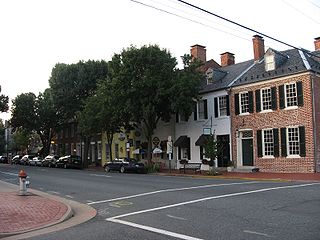
Fredericksburg is an independent city in Virginia, United States. As of the 2020 census, the population was 27,982. It is 48 miles (77 km) south of Washington, D.C., and 53 miles (85 km) north of Richmond. The Bureau of Economic Analysis of the United States Department of Commerce combines the city of Fredericksburg with neighboring Spotsylvania County for statistical purposes.
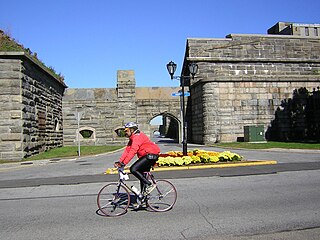
Fort Schuyler is a preserved 19th century fortification in the New York City borough of the Bronx. It houses a museum, the Stephen B. Luce Library, and the Marine Transportation Department and Administrative offices of the State University of New York Maritime College. It is considered one of the finest examples of early 19th century fortifications. The fort was named in honor of Major General Philip Schuyler of the Continental Army.
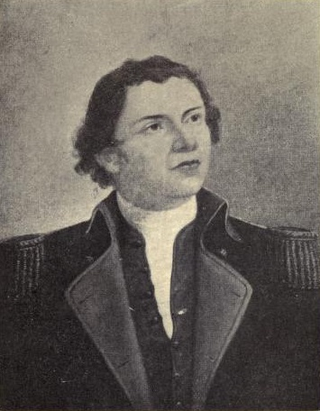
Hugh Mercer was a brigadier general in the Continental Army during the American Revolutionary War. He fought in the New York and New Jersey campaign and was mortally wounded at the Battle of Princeton.

Ferry Farm, also known as the George Washington Boyhood Home Site or the Ferry Farm Site, is the farm and home where George Washington spent much of his childhood. The site is located in Stafford County, Virginia, along the northern bank of the Rappahannock River, across from the city of Fredericksburg. In July 2008, archaeologists announced that they had found remains of the boyhood home, which had suffered a fire during 1740, including artifacts such as pieces of a cream-colored tea set probably belonging to George's mother, Mary Ball Washington. In 2015, the George Washington Foundation began constructing a replica of Washington's boyhood home on the site of the original building. The replica house was completed in 2018 and is open to the public.

Fredericksburg and Spotsylvania National Military Park is a unit of the National Park Service in Fredericksburg, Virginia, and elsewhere in Spotsylvania County, commemorating four major battles in the American Civil War: Fredericksburg, Chancellorsville, The Wilderness, and Spotsylvania.

Robert Brooke was a Virginia planter, soldier, lawyer, and politician who served as the tenth Governor of Virginia as well as in the Virginia House of Delegates, and as Attorney General of Virginia at the time of his death.

Buildings, sites, districts, and objects in Virginia listed on the National Register of Historic Places:

Fielding Lewis was an American merchant, member of the House of Burgesses and a Colonel during the American Revolutionary War. He lived in Fredericksburg, Virginia and also owned a plantation in Spotsylvania County, which later became known as Kenmore. His brother-in-law was George Washington.
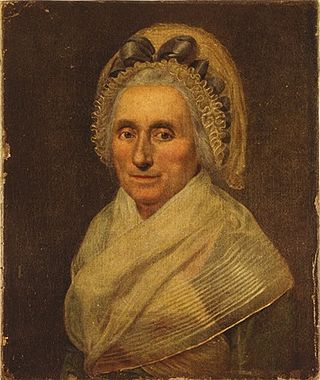
Mary Washington was an American planter best known for being the mother of the first president of the United States, George Washington. The second wife of Augustine Washington, she became a prominent member of the Washington family. She spent a large part of her life in Fredericksburg, Virginia, where several monuments were erected in her honor and a university, along with other public buildings, bear her name.

Fort Baldwin is a former coastal defense fortification near the mouth of the Kennebec River in Phippsburg, Maine, United States, preserved as the Fort Baldwin State Historic Site. It was named after Jeduthan Baldwin, an engineer for the Continental Army during the American Revolution. The site was listed on the National Register of Historic Places in 1979.

Kenmore, also known as Kenmore Plantation, is a plantation house at 1201 Washington Avenue in Fredericksburg, Virginia. Built in the 1770s, it was the home of Fielding and Betty Washington Lewis and is the only surviving structure from the 1,300-acre (530 ha) Kenmore plantation.
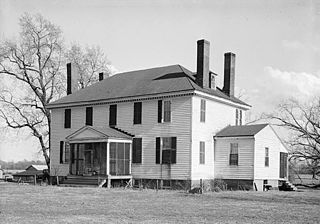
Weyanoke is a plantation farmstead in Charles City County, Virginia, United States. In 1619, the First Africans in Virginia arrived at the Weyanoke Peninsula. They created the first African community in North America. The Westover Plantation and related archaeological sites were listed on the National Register of Historic Places in 1980.
Charles Freeman Gillette (1886–1969) was a prominent landscape architect in the upper South who specialized in the creation of grounds supporting Colonial Revival architecture, particularly in Richmond, Virginia. He is associated with the restoration and re-creation of historic gardens in the upper South and especially Virginia. He is known for having established a regional style—known as the "Virginia Garden."
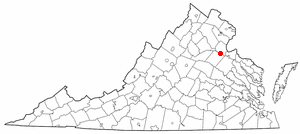
This is a list of the National Register of Historic Places listings in Fredericksburg, Virginia.

This is a list of the National Register of Historic Places listings in Spotsylvania County, Virginia.

This is a list of the National Register of Historic Places listings in Stafford County, Virginia.

Kenmore,, is a historic house in Spotsylvania County, Virginia, United States. It was built in 1829 by Samuel Alsop, Jr. (1776–1859) for his daughter Ann Eliza and her husband, John M. Anderson. The home bears the same name as the home of Fielding and Betty Lewis in nearby Fredericksburg, Virginia. To distinguish the houses, Kenmore in Spotsylvania County was renamed Kenmore Woods. Samuel Alsop, Jr. designed a number of homes in Spotsylvania County. In addition to Kenmore, he also designed and built "Oakley" for another daughter as well as his own home, "Fairview". In all, Alsop designed and built 10 homes.

Massaponax Baptist Church is a Baptist church built in the Greek Revival style, located in Spotsylvania County, Virginia. It is affiliated with the Southern Baptist Convention. The Baptist congregation that built the church was established in 1788 at a small church near Massaponax Creek. When that building became too small to hold the growing congregation, the church was moved to its present location at the intersection of U.S. Route 1 and State Route 608. The new church was a small, frame building which was also outgrown. In 1859, the current brick building was constructed on the site. Kilns in a nearby field fired the bricks for the exterior walls. By October 1859 the new church was completed at a cost of $3,000. Joseph Billingsly was the first pastor in the new building. An addition was built in 1949 and a brick cottage for the pastor, was built near the church in 1956. The church was listed on the National Register of Historic Places in January 1991.

The Lewis Store, also known as the Fielding Lewis Store, is a historic commercial building located at Fredericksburg, Virginia. It was built in 1749, and is a two-story, front-gable, three-bay Georgian style brick store. The second story addition was built in 1808. The building was rehabilitated between 2000 and 2006. The first story consists of a "sales room" on the front and a "counting room" on the rear. The building functioned as a store until 1823, after which it was used as a residence. It was built by John Lewis and operated by him and his son, Fielding Lewis, who was married to George Washington's sister Betty Washington Lewis. Fielding and Betty Lewis built the nearby Kenmore. The Lewis family sold the store in 1776.




















